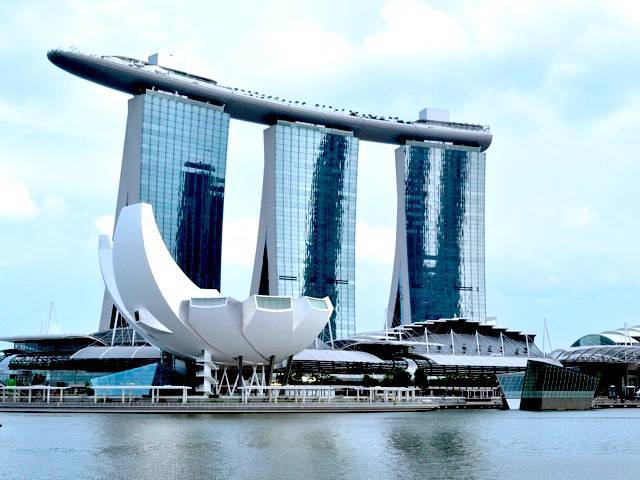The world’s first ArtScience Museum at Marina Bay Sands, designed by internationally-acclaimed architect Moshe Safdie, was unveiled to the world on the auspicious date and time of 17 February 2011 at 1.18pm.
Boasting an iconic lotus-inspired design, the ArtScience Museum symbolizes “The Welcoming Hand of Singapore” to visitors from across the world.
The ArtScience Museum at Marina Bay Sands is set to become the heart of the growing ArtScience movement as well as the premier venue for major international touring exhibitions from the most renowned collections in the world.
Featuring 21 gallery spaces totaling 50,000 square feet, the latest addition to Marina Bay Sands will deliver an impressive array of exhibits that embrace a spectrum of influences from art and science, media and technology, to design and architecture.
A permanent gallery, the ArtScience Gallery will take visitors on a journey inside the creative process across three unique spaces: Curiosity, Inspiration and Expression. The Museum’s showpiece exhibition, the ArtScience Gallery, is an homage and introduction to the nascent field of ArtScience.
What unites Art and Science is the instinct to observe, connect, take risks and explore new ideas and ways of understanding nature’s wisdom and experiences that shape our culture. Visitors to the ArtScience Gallery will explore these mysterious connections between the arts and the sciences through the three galleries thus undergoing their own journey of creativity.

The Museum’s showpiece exhibition, ArtScience: A Journey Through Creativity, will feature a series of permanent exhibits designed to anchor the venue at the forefront of technology, design and culture.
Marquee exhibitions curated by leading museums and collections include “Genghis Khan” and “Travelling the Silk Road” making exclusive Asian appearances at the ArtScience Museum.

Traveling the Silk Road: Ancient Pathway to the Modern World will be on show from February 17 to March 27, 2011. Organized by the American Museum of Natural History and making its debut in Asia, this exhibition recreates the ancient cities of Asia and the Middle East between AD 600 and 1200. Occupying approximately 1,500 square meters, this interactive exhibition will literally immerse visitors in the sights, sounds and even smells of the bustling marketplaces in Asia and the Middle East.
Visitors will get to use a working model of an ancient astrolabe; view a replica of a Tibetan Buddhist sutra, or religious manuscript, made of exquisite silk; and get up close to a rubbing from a section of the more than 1,200-year-old Nestorian stele, which is an engraved stone pillar erected in Xi’an in 781 still standing today.
Other highlights will be a two-foot-tall working model of a water clock designed by Islamic engineers 800 years ago and a 120-foot long mural – one of the largest ever painted for a museum travelling exhibition. Young visitors will have fun collecting stamps in a “passport” while on their Silk Road adventures, and enjoy computer-animated books that bring to life timeless tales told by Silk Road travelers.

Genghis Khan: The Exhibition takes visitors on a journey back to 13th century Mongolia with stunning re-creations of Mongolia’s grasslands and battlegrounds, complete with archaeological artifacts and weaponry of the Mongol Empire.
It tells the story of Genghis Khan whose innovation, technological mastery and cultural creativity gave the legendary conqueror the reputation of one of the world’s greatest yet most misunderstood leaders.
With over 200 rare authentic treasures – the largest collection of Genghis Khan artifacts ever assembled – from the conqueror’s reign, visitors can touch, see and even smell scenes of Mongolian life and develop a deeper understanding of Genghis’ time.
The exhibition will shed light on the influence the Mongol empire had on culture, international law and finance even to this day. Visitors can also get an insight into how many of our modern-day inventions such as the passport, paper money, libraries and even trousers can be attributed to the vision of one of the world’s greatest innovators.

Hailed as the city’s new “great cultural symbol”, the museum looks to deliver an internationally renowned forum for the exchange of the latest creative ideas and theories.
In the coming months, the museum will launch a speaker series that will bring globally renowned thought-leaders in the field of ArtScience to Singapore to drive discussion and further generate ideas on the subject.
The architecture of the ArtScience Museum represents an iconic presence along the Marina Bay waterfront, featuring 10 “fingers” anchored by a unique round base in the middle. The design of each finger reveals different gallery spaces featuring skylights at the “fingertips” that illuminate the dramatically curved interior walls.

The Museum’s dish-like roof channels rainwater through the central atrium of the building creating a 35-meter water drop into a small, reflecting pool. The rainwater is then recycled for use in the building’s restrooms.
Material such as Glass Fiber Reinforced Polymer (GFRP), typically used in high-performance racing yachts, which has never been used in a project in Singapore, was used for the construction of this architectural wonder.
















SENATUS Member Comments